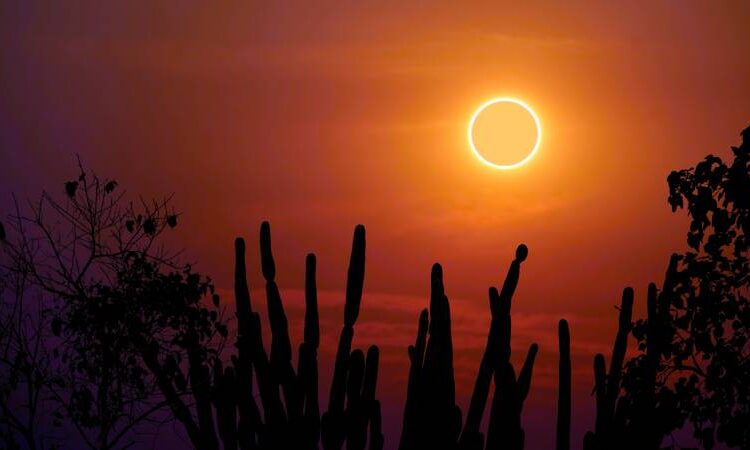This coming Saturday morning, on October 14th, an annular solar eclipse is set to grace the skies of the Southwestern United States. During this celestial event, observers will witness a captivating “ring of fire” encircle the obscured new moon, providing a stunning spectacle.
This rare occurrence will not grace the U.S. skies for another two decades, making it a highly anticipated event among astronomers. They are encouraging anyone who can to venture outdoors and safely witness this unique phenomenon. Meanwhile, in other parts of the country, skywatchers will have the opportunity to witness a partial solar eclipse, where the moon partially conceals the sun.
While this weekend’s event might not generate the same level of excitement as the total solar eclipse slated for next April, it is still an event not to be missed. Here’s a comprehensive guide to this upcoming astronomical wonder.
When and Where Will the Eclipse Occur?
In the United States, the annular eclipse will commence in Oregon at 9:13 a.m. Pacific Time and conclude in Texas at 12:03 p.m. Central Time, according to NASA. It will traverse across Mexico’s Yucatán Peninsula, Central America, then make its way through Colombia and Brazil, eventually fading into the Atlantic Ocean at sunset.
While people throughout the continental U.S. will have the chance to witness at least a partial eclipse, the mesmerizing “ring of fire” will only be visible to those in Oregon and the Southwest. This unique phenomenon won’t grace the country’s skies again until 2046. So, if you’re contemplating making the journey to the eclipse’s path by car, bus, or plane, it may very well be worth the effort.
Moreover, a total eclipse is on the horizon and will be visible across a large portion of the U.S. on April 8, 2024. Even those outside the path of totality will still be treated to a partial eclipse.
To find out when this Saturday’s annular eclipse will be visible in your location, you can use an interactive map or download the Totality app provided by the American Astronomical Society for more details.
The Science Behind a Solar Eclipse
A solar eclipse takes place when the moon moves between the sun and Earth, casting a shadow on our planet. There are three primary types of solar eclipses: total, partial, and annular. Occasionally, when multiple phenomena coincide, Earth experiences a hybrid eclipse.
We are fortunate to witness total eclipses due to a cosmic coincidence: the moon, which is 400 times smaller than the sun, is also 400 times closer to Earth than the sun. Consequently, from Earth’s perspective, these two celestial bodies appear to be the same size. Therefore, during rare instances when the moon precisely aligns with the sun, it completely obscures the sun, plunging the sky into darkness akin to dawn or dusk. During a total eclipse, the sun’s corona, its outer atmosphere typically hidden by the sun’s brilliance, becomes visible. It is the only eclipse type during which viewers can briefly remove their protective eclipse glasses.
However, the moon follows an elliptical orbit around Earth. Occasionally, a solar eclipse happens when the moon is at or near its farthest point from Earth, causing it to appear smaller in our sky. This results in an annular eclipse, during which the sun is not entirely blocked, creating a brilliant “ring of fire” encircling the moon.
A partial solar eclipse occurs when the sun, moon, and Earth are not perfectly aligned, leading to only a portion of the sun being covered, giving it a crescent shape.
Eclipses offer a unique opportunity to study our atmosphere under unusual conditions, according to NASA. During the 2017 total solar eclipse, the space agency funded 11 studies to collect data available exclusively during these extraordinary events.
Tips for Observing the Annular Eclipse
Because the moon will never completely obscure the sun this Saturday, it is essential to view the eclipse through eclipse glasses or an indirect solar viewer for its entire duration.
“There will be no time in October when it is safe to look directly at the sun without eye protection,” warns Rick Fienberg, the project manager of the Solar Eclipse Task Force at the American Astronomical Society. “It is dangerously bright.”
It’s important to note that eclipse glasses are distinct from regular sunglasses. Eclipse glasses block out approximately 99.9 percent of light rays, as explained by Russell Van Gelder, a clinical spokesperson and former president of the American Academy of Ophthalmology. In contrast, regular sunglasses only block about 60 percent of light rays and should not be used for eclipse viewing, as per Time magazine’s Lisa Marie Segarra in 2017.
When purchasing eclipse glasses online, ensure that you buy them from a reputable company or organization. In the lead-up to the 2017 eclipse, counterfeit glasses inundated the market for weeks. To steer clear of fraudulent solar viewers, stick with suppliers recommended by the American Astronomical Association. In preparation for this Saturday, it’s advisable to examine your solar filter for any scratches or tears and discard any damaged devices.
If you’re unable to obtain eclipse glasses by Saturday, there’s no need to lose hope. You can indirectly witness the event using a DIY pinhole camera fashioned from cardstock, aluminum foil, tape, and a pencil. Remember never to gaze directly at the sun through your pinhole device, and avoid looking at it directly through the lenses in camera viewfinders, telescopes, or binoculars.
Be sure to check your local weather forecast to ensure that your view won’t be obstructed by clouds and select a safe location away from roads to observe the sky.
Eclipse History and Culture
The term “eclipse” originates from the ancient Greek word “ekleipsis,” meaning “abandonment.” The ancient Greeks believed that a total eclipse was an ominous sign, indicating that the gods would punish their king. Greek astronomers tracked the movements of the sun, moon, and planets using an ancient device known as the Antikythera mechanism, which also helped predict lunar and solar eclipses.
The earliest recorded eclipse in human history possibly occurred in Ireland on November 30, 3340 B.C.E. Researchers discovered a series of carvings in stone that some interpreted as depictions of a solar eclipse. Physical records of past eclipses have been unearthed worldwide, including 2,500-year-old clay tablets from Babylonia. Various ancient and contemporary cultures hold diverse beliefs and practices related to eclipses.
This year, the eclipse’s path will traverse directly through Indigenous lands in the Four Corners region of the Southwest. In Navajo (Diné) culture, the eclipse holds associations with death and rebirth, serving as a time for reflection.
Nancy Maryboy, a Cherokee and Navajo cultural astronomer and president of the Indigenous Education Institute, explains that Navajos have traditional protocols surrounding eclipses, involving reverence and respect for celestial phenomena. Traditionally, Navajos would retreat to their homes, observing an eclipse in silence, refraining from eating or drinking. While many still adhere to this practice, some within the Navajo Nation may choose to observe the eclipse, and there’s no single “right way” to approach it, as per Maryboy.
Disclaimer: The views, suggestions, and opinions expressed here are the sole responsibility of the experts. No Euro Currents journalist was involved in the writing and production of this article.





